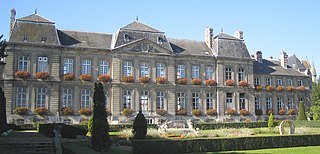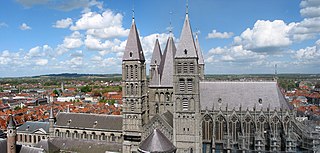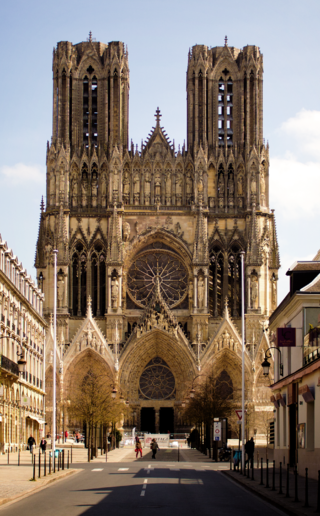
The Labyrinth of the Reims Cathedral was a church labyrinth installed on the floor of the nave of the Reims Cathedral.

The Labyrinth of the Reims Cathedral was a church labyrinth installed on the floor of the nave of the Reims Cathedral.
The labyrinth was the shape of a complex square with cut corners and sides of 10.36 metres (11.33 yd) . [1] The paths were 27.94 centimetres (11.00 in) wide, separated by lines of dark blue stone from Ardennes of a width of 11.43 centimetres (4.50 in). [2] The labyrinth was made of soft stone that wore out beneath the feet of pilgrims. This stone was of the same kind as Pierre Libergier's tombstone that is now exhibit in the cathedral. [2]
A distinctive aspect of the labyrinth was the inclusion within it of depictions of the master masons of the cathedral. In other churches and cathedrals, they are unknown and anonymous. Indeed, the identities of these master masons are precisely known, because a survey of the labyrinth was drawn in 1640 by Canon Cocquault and in 1779, just before its destruction, by Robin and Havé. These surveys also contained dates and descriptions of the masons' works. [2]
The person at the center of the labyrinth is generally identified as Aubry de Humbert, Archbishop of Reims, who decided in 1211 to build a new cathedral in the place of the one destroyed by fire in 1210. [3]
The people in the corners of the labyrinth are successive master masons of the cathedral: [1] [2] [3]
Bernard de Soissons was in charge during the inauguration of the labyrinth. There is no trace of the fifth (and probably best-known) contractor, Robert de Coucy, who was in charge from 1290 to 1311 and who oversaw the carpentry and the roof. [2]
The masons are represented hard at work, with their tools in hand. For example, Jean d'Orbais appears to draw a map on the floor. [2]
There were also two other silhouettes on each side of the entrance of the labyrinth; however, these could not be identified because they were already almost completely eroded. [2]

The church labyrinths were polychrome pavements symbolizing the rise[ clarification needed ] of Christ at Calvary. [4] Christian people followed them on their knees as a symbolic pilgrimage or to win indulgences [3] [4]
The labyrinth was inaugurated at the coronation of Philippe le Bel on 6 January 1286. [2] It covered the central part of the nave at the third and fourth spans. [2] [3]
The labyrinth was destroyed in 1779 by the Canons (priests charged with running the cathedral), who were disturbed by children playing on the labyrinth during ceremonies. [3]

A plan to rebuild the labyrinth ran into technical and administrative difficulties. [4] Instead, a choice was made to undertake a reversible and nondamaging reconstruction. This took the form of a light projection on the ground that plays only in the evening, during cultural events. It was inaugurated on 19 September 2009. [4]
The labyrinth has been chosen as the national logo for French historical monuments ("monuments historiques"). This logo depicts the labyrinth without people, rotated by 45°, and often in a dark red color.


Chartres Cathedral, also known as the Cathedral of Our Lady of Chartres, is a Catholic church in Chartres, France, about 80 km southwest of Paris, and is the seat of the Bishop of Chartres. Mostly constructed between 1194 and 1220, it stands on the site of at least five cathedrals that have occupied the site since the Diocese of Chartres was formed as an episcopal see in the 4th century. It is one of the best-known and most influential examples of High Gothic and Classic Gothic architecture, It stands on Romanesque basements, while its north spire is more recent (1507–1513) and is built in the more ornate Flamboyant style.

Soissons is a commune in the northern French department of Aisne, in the region of Hauts-de-France. Located on the river Aisne, about 100 kilometres (62 mi) northeast of Paris, it is one of the most ancient towns of France, and is probably the ancient capital of the Suessiones. Soissons is also the see of an ancient Roman Catholic diocese, whose establishment dates from about 300, and it was the location of a number of church synods called "Council of Soissons".

Tours Cathedral is a Roman Catholic church located in Tours, Indre-et-Loire, France, and dedicated to Saint Gatianus. It is the seat of the Archbishops of Tours, the metropolitan cathedral of the Tours ecclesiastical province. It was built between 1170 and 1547. At the time construction began, the church was located at the south end of the bridge over the river Loire, on the road from Paris to the south-west of France. It has been a classified monument historique since 1862. Since 1905 it has been owned by the French State, with the Catholic Church having the exclusive rights of use.

The Cathedral Basilica of Our Lady of Amiens, or simply Amiens Cathedral, is a Roman Catholic church. The cathedral is the seat of the Bishop of Amiens. It is situated on a slight ridge overlooking the River Somme in Amiens, the administrative capital of the Picardy region of France, some 120 kilometres north of Paris.

The Cathedral of Saint Peter of Beauvais is a Roman Catholic church in the northern town of Beauvais, Oise, France. It is the seat of the Bishop of Beauvais, Noyon and Senlis.

The Cathedral of Our Lady, or Tournai Cathedral, is a Roman Catholic cathedral, see of the Diocese of Tournai in Tournai, Belgium. It has been classified both as a Wallonia's major heritage since 1936 and as a World Heritage Site since 2000.

Soissons Cathedral is a Gothic basilica church in Soissons, France. It is the seat of the Bishop of Soissons, Laon, and Saint-Quentin. The construction of the south transept was begun about 1177, and the lowest courses of the choir in 1182.

French Gothic architecture is an architectural style which emerged in France in 1140, and was dominant until the mid-16th century. The most notable examples are the great Gothic cathedrals of France, including Notre-Dame Cathedral, Reims Cathedral, Chartres Cathedral, and Amiens Cathedral. Its main characteristics are verticality, or height, and the innovative use of the rib vault and flying buttresses and other architectural innovations to distribute the weight of the stone structures to supports on the outside, allowing unprecedented height and volume. The new techniques also permitted the addition of larger windows, including enormous stained glass windows, which fill the cathedrals with light.

Châlons Cathedral is a Roman Catholic church in Châlons-en-Champagne, France, formerly known as Châlons-sur-Marne.
Robert De Coucy or Courcy, born Reims was a medieval French master-builder and son of a master-builder of the same name.

Poix-Terron is a commune located in the department of Ardennes, in the Grand Est region of France.

High Gothic followed Early Gothic architecture and was succeeded in France by Late Gothic in the form of the Flamboyant style. This timetable is not used by French scholars; they divide Gothic architecture into four phases, Primary Gothic, Classic Gothic, Rayonnant Gothic and Flamboyant Gothic. Therefore, in French terms, a few first examples of High Gothic are Classic, but most examples are Rayonnant. High Gothic is often described as the high point of the Gothic style.

Jean d'Orbais was a French architect from Orbais-l'Abbaye, active in the Reims area. He was an architect of the High Gothic style and the first of the four architects of the Cathedral of Reims, where he is depicted in the labyrinth mosaic in the nave. He was responsible for the design of and initial work on the cathedral of Notre Dame de Reims.

The Cathedral of Notre Dame of Lausanne is a church located in the city of Lausanne, in the canton of Vaud in Switzerland. It is owned by the Evangelical Reformed Church of the Canton of Vaud.

Notre-Dame de Reims, known in English as Reims Cathedral, is a Roman Catholic cathedral in the French city of the same name, the archiepiscopal see of the Archdiocese of Reims. The cathedral was dedicated to the Virgin Mary and was the traditional location for the coronation of the kings of France. Reims Cathedral is considered to be one of the most important pieces of Gothic architecture. The cathedral, a major tourist destination, receives about one million visitors annually. It became a UNESCO World Heritage Site in 1991.

Hugues Libergier (Unknown–1263) was a medieval French architect and master mason of the Gothic era who worked in Reims, France. He contributed to the Rayonnant Gothic style, and notably directed the building of the Old Church of Saint-Nicaise de Reims begun in 1231. Libergier is commemorated on a tomb slab that now resides in Reims Cathedral.

Classic Gothic is a French term for the second phase of Gothic architecture in France, as defined by French scholars. The common English term for the period is High Gothic. This is disputed by German scholars. The German definition of High Gothic requires bar tracery, which did not arrive in French cathedrals until the construction of Reims Cathedral, but the English definition does not.
{{cite book}}: CS1 maint: location (link){{cite book}}: CS1 maint: location (link)